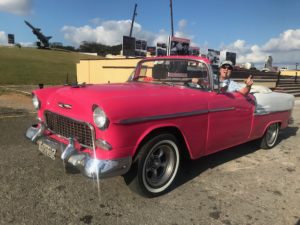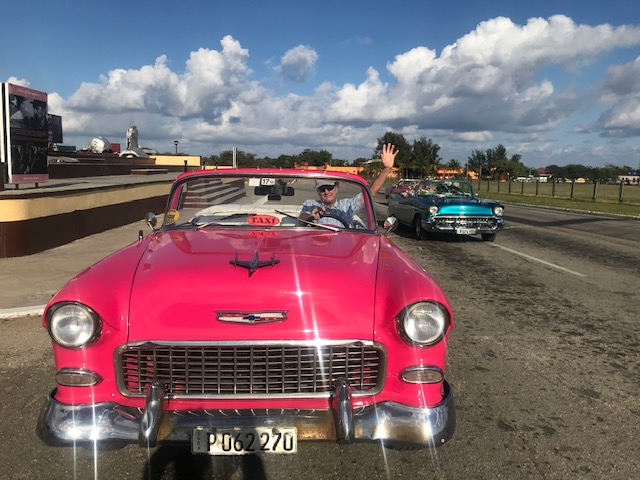Two Options
Walking the streets: two-hours, 3-miles, or
Driving the Streets; in a shiny pre-1960 vintage American car?
Both!
Why the streets of Havana appeal to me
Havana’s well-manicured public parks, line the streets. History is on display along Caribbean waterfronts. Spanish architecture dominates Havana, Cuba’s capital is not another “Caribbean town.” Cuban music jumps out every block along the route.
Where Down the Block do we Start?
First let’s walk.
Head north from the ferry terminal 200 meters. Pause on the harbor side of the walk at the base of O’Reilly Street, where it joins Ave Del Puerto Desamparados. Walk away from the port, towards the city to Plaza de Armas. Cross O’Reilly street into the grounds of Castillo de la Real Furza.
Exit the Castillo grounds on the harbor side. The Malecon walkway follows Havana’s channel. Continue along the waterfront channel leading into/out of the port of Havana. At the sea entrance to Havana’s channel, a lighthouse guards the east side of the entrance.
Shake your head, NO. Wave off the drivers of the 1905 vintage cars as they patrol the boulevard, calling, “Tour of Havana?” Driving the streets comes later.
Across Ave. Del Puerto Desamparados, on the city-side, is Park Luz Caballero, .35 miles. Next on Park Cespedes, .5 miles. Ahead lies San Salvador Castle Point, you’ve walked .9 of a mile.
Approaching San Salvador, vintage car riders will be crossing the Entrance Channel via an underground tunnel. On the NE side of the channel two forts and a lighthouse guard the port of Havana.
Reaching San Salvador Castle Point on foot, turn hard left. Paseo Marti is a marble pedestrian urban park that leads to Park Central, 1.6 miles, and the magnificent Capitolio, 1.8 miles. Along the Paseo de Marti; the Royal Prison, Cuba’s Revolution Museum, Museum of Art.
Past Parque Central (heading south), continue to Partagas’ (cigar) factory/retail shop, just behind (west of) the Capitolio on Industria Street (Calle Industria), 2.0 miles. Partagas retail sells all the major cigar brands produced in Cuba. Cigar Price is regulated in Cuba. There is no advantage is seeking out a discount cigar vendor – they offer knock-off cigar brands.
Walk back to Parque Central (2.2. miles), grab a bench seat in the shade on this fabulous plaza. Analyze your options; walk, ride. Confused? Take a break, enter the Hotel Parque Central. Ride the elevator to floor 8, the pool deck (no food service) for the view. Slake your thirst by repairing to Hotel Parque Central’s lobby bar.
Outside Parque Central, a row of vintage cars stand ready to serve. Continue walking, or ride – still not certain?
Head into the lobby of neighboring Gran Hotel Manzano Kempinski. Kempinski’s restaurant/bar on floor 6 overlooks all of Havana – while offering great nibbling/drinking options. Settle in. Food is pricy, drinks are not, $4 for Cuban beer. Kempinski’s 6th floor with its 270-degree view, is not Communist Old Havana, but you can see it from here. Like everywhere in Havana, the 6th floor bar is cigar friendly.
Why you might not leave
My bartender Omar, from behind his altar on Kempinski’s 6th level bar, said, “This might be the best location for an after-dark beverage and cigar in all of Cuba.” It was 7:30 pm, I was back; smoking a Montecristo #2, sipping a Bucanegra beer.
Omar was insightful.
Lesser Known Facts
Havana Club Rum is sold in the USA by Bacardi. In the rest of the world (Cuba), Havana Club is sold by Pernod and the Cuban government in a 50-50 venture. Bacardi’s recipe differs from Pernod’s.

A Ron Collins (rum) cocktail may be a throw-back to your ancestors 1950’s parties, but it is still mixed and served in Havana.
Partagas’ cigar shop, two blocks from Parque Centrale offers all makes of Cuban cigars; Montecristo, Cohiba, Romeo & Julietta.
There are no beaches for swimming in Old Havana.
Local Recommendation
You’re winding down on two hours embedded at the Gran Hotel Manana Kempinski 6th floor.
How to return to our Start Point walking the streets of Havana?
Slow, slightly downhill, one step at a time. Leaving the Hotel Kempinski, head east towards the port on Obispo Street.
Skip Bar Floridita, a reputed favorite stop for Ernest Hemingway. Floridita is packed with tourists. The visiting interlopers slurp green, county-fair style, snow-cones the bar staff foists as daiquiris. Fifty-plus icy, little green melters are lined atop Floridita’s bar in communist mock-tribute to America’s capitalistic production line efficiencies.
Worthwhile pauses while walking down Obispos street:
Restaurant Europa, Obispo Street, Cuban jazz pulls you to their gate.
La Ruinas del Parque, the music plays all afternoon.
Restaurante 5 Sentidos, San Juan de Dios 67, a Cuban paladar. Found on the corner of Habana and Compostela, two block detour, north, halfway down Obispo. Sample the octopus appetizer.
Hotel Ambos Mundos; the caged elevator serving the lobby, delivers you to Ambos Mundos’ rooftop deck.
Something for Nothing
My ranking
1. The parks of Havana, well-manicured.
1. The façade of Havana’s federal building; The CAPITOLIO. Perhaps the Caribbean’s most magnificent building.
1. Parque Centrale, this plaza features a statue of Jose Marti. Marti, organized and unified Cuba’s struggle for independence from Spain. The Marti name is a synonym for liberty throughout Latin America.
What about a Vintage Car Tour?
Jubal drove, I rode shotgun. Inside Jubal’s fluorescent pink convertible, it was 1955. Outside it was 9:30 am on a January, Monday morning in Old Havana. The bench seats of Jubal’s Chevrolet Bel Air were covered with sturdy clear plastic, providing a wax-paper slide from steering column to passenger door as Jubal turned a corner.

I avoid bumping the manual gear shift jutting from the right-hand side of the steering column. Jubal executes a classic 1950 style gear-shift from Reverse, through First, Second and Third;
Depress clutch, pull shift toward driver, yank down, lock, release clutch. Accelerate, clutch-in, lift shift, push forward, up and lock into 2nd gear. 3rd gear is a straight down-slam, clutch out. Who could forget learning to drive a stick shift?
Jubal drove his 55’ Chevy convertible north along Avenue del Porto, leading seaward from Old Havana’s commercial harbor.
Jubal spoke little English, I speak no Spanish. We were talking cars and politics.
“Original engine,” Jubal shouted in English.
“Incredible,” I replied in Italian, confusing Jubal and myself.
Jubal wore a white, Boston Blacky style, hat. Both of our heads from eyebrows up were above the blow line pushing over the wind shield.
Jubal turned left, heading down, into the Tunnel del la Habana, crossing the Canal de Entrada. Exiting on the east side of the port of Habana. The slight centrifugal pull of the Chevy Bel Air’s left turn, slid me against the interior passenger door.
NO DOOR HANDLE! Perfect, Jubal’s 55’ classic was tricked out for Friday night, Drive-In Movie, dating; no seat belts, lazy-Susan bench seats, no interior escape handle on the passenger side door.
“Where you wan go?” Jubal asked.
“Anywhere,” I said to keep communication simple. It was 80 degrees, no clouds. Havana streets ran thick with vintage Americana transportation. Somewhere Cuban Bucanegra beer stood chilling. So long as our 1955 Chevy Bel Air convertible didn’t lift off the ground and fly towards Florida seeking vehicular asylum, I was smiling and waving.
Jubal honked at the Havana residence of Che Guevara. He pulled his ride to a stop at a nearby park.
Jubal pointed, “Missile monument.” In the poster, Fidel pointed back.
“Fidel say you coming to take our missiles, prepare for fight,” Jubal said.
I nod, remembering 1963.
Jubal said, “Biggest news in Cuba summer 1963. Same in US?”
“No,” I said, “2nd biggest. Ed Sullivan announced the Beatles would be on his Sunday night TV show.”
Jubal looked sad, “Castro ban Beatle music here in Cuba, he say capitalist trick.”
Beatles music banned in Cuba? Seemed to me John Lennon and his Beatles were a bit commie at times?

We drove west along the Malecon towards Vedado. Havana when constructed, was a European city. The skeleton of the Spanish opulence can be traced, a black and white outline of a once-grand city. Havana is not a Caribbean city.
